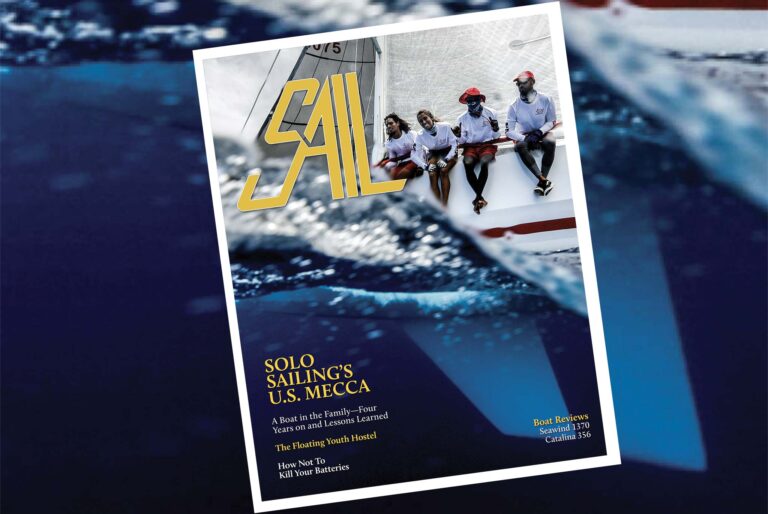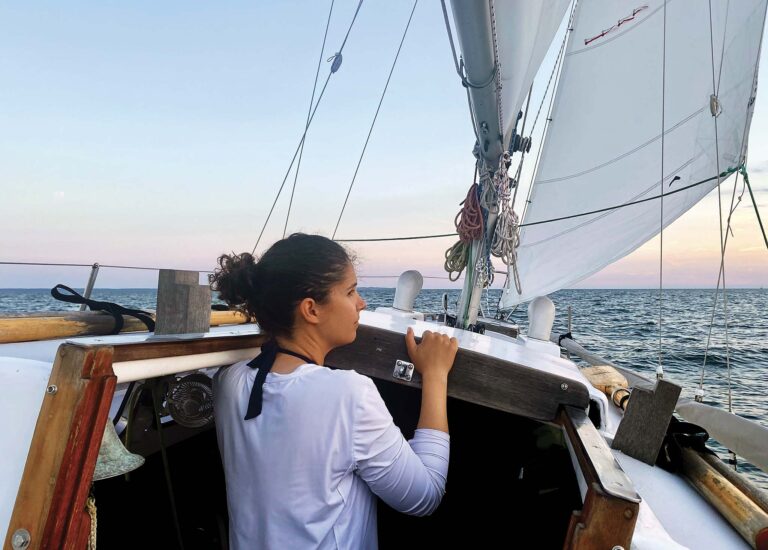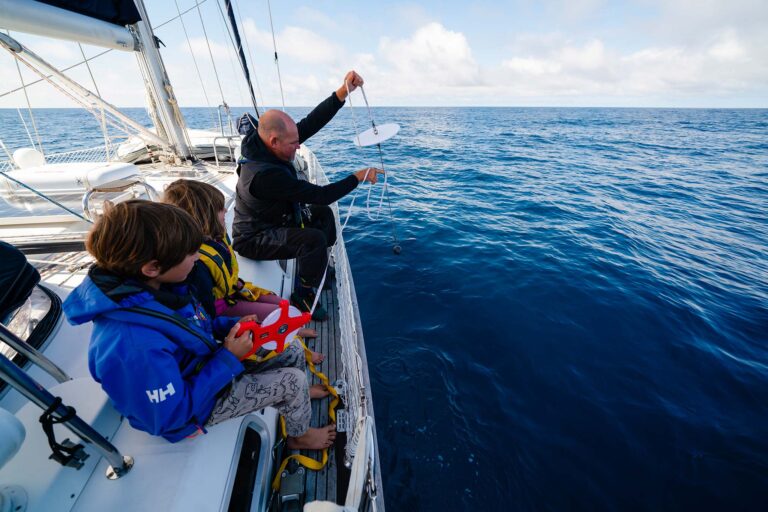
There are only a handful of villages scattered across the more than 360 islands, islets and sandbars that make up the Exuma archipelago in the Bahamas. Cruising there you’ll have no trouble finding plenty of beaches and bays to explore. Most likely you’ll only have to share them with iguanas, palm trees and, perhaps, some swimming pigs.
My partner, Michaela, and I recently explored this magical chain of islands, which runs 130 miles from Great Exuma Island in the south to Norman’s Cay in the north. We chartered with Navtours, pretty much the only charter outfit in the region, starting out from the company’s base in Great Exuma and sailing one-way to its other base in Nassau.
The Exumas run along the eastern edge of the Grand Bahamas Bank. As such, the waters inside or west of the chain are protected, shallow and generally calmer than those outside on the eastern side, which consist of deep, open ocean. However, sailing on the bank side can also be tricky, as some stretches are too shallow for deep-keel boats.

Our Beneteau 39 drew 6ft, so we had to spend our first few days sailing outside in open water. This proved challenging, as conditions were unseasonably rough, with 30-knot winds and fairly big seas.
Needless to say, it was nice to tuck back inside at Lee Stocking Island, our first anchorage and home to the Perry Institute for Marine Science, a large marine biology research center financed by John H. Perry Jr., a newspaper tycoon and avid diver.
In 2012, six years after Perry’s death, the research station shut down, leaving behind laboratories, fish tanks, generators and offices that look pretty much like they did when the place was operational, albeit in disrepair. Lee Stocking also has a couple of very nice beaches for those who want to kick-start their tanning regime. A short hike inland from the beach will take you to the top of Perry Hill, the highest point in the Exumas at 100ft above sea level. It’s not exactly a dizzying height, but it’s high enough to provide some pretty great views.

Leaving Lee Stocking, it was still too shallow to sail on the inside, so we headed back out into the big seas to continue our journey north. You have to be a little careful navigating the passes between the inside and outside. They can be narrow and shallow, and the waves and currents can get hairy. Whenever possible we tried to hit these at high slack tide to avoid surprises.
After a spirited sail we arrived at our next destination, Rudder Cut Cay. The legendary illusionist David Copperfield owns this island, along with 10 other islands in the region. Musha Cay is likely the best known of these properties, as it’s home to his high-end private resort of the same name. At $30,000 a night (for the entire island), we figured it was beyond our cruising budget.
We did, however, enjoy the long sandy beach on the inside of Rudder Cut Cay. (In the Bahamas, beaches are public up to a little above the high tide mark.) If you ever stop there, be sure to check out the little sea cave. It has a “mini” beach inside that’s just big enough for two and is a perfect shaded lunch spot.
This was only the first of a couple of caves we visited in the Exumas. On Great Guana Cay, a few islands north of Copperfield’s compound, we found a huge subterranean cavern with fantastic Salvador Dali-esque melted calcium formations guarding a small crystal blue lake of filtered fresh water. The cave is pretty easy to find; just look for some trail markers at the northern end of Oven Rock Beach and follow them up the hill.
After Great Guana Cay, the water inside became deep enough for us to sail on the west side the rest of the way north. Heavy seas and big air can be exhilarating, but it was a nice to cruise in relatively calm water again.
Staniel Cay, our next stop, is a favorite destination for megayachts. Staniel Cay Yacht Club operates a good-size marina here, as well as a kicking bar/restaurant. You’ll want to make reservations in advance, as they do not take walk-ins. There are also some other good dining options, not to mention two much-needed grocery stores.

Staniel is where they you’ll find “Thunderball” Grotto—named after the 1965 James Bond movie of the same name that was filmed here. You can either swim into the cave or jump in through a hole in the roof (literally). This protected spot (fishing is not allowed) is a veritable marine sanctuary filled with colorful tropical fish and beautiful coral. Light filtering through a number of underwater holes that lead out to the sea illuminates the water and the walls of the cave—it’s simply magical.
A word of warning: Thunderball Grotto has some strong tidal currents that can suck you through the cave. I got caught, and it took every bit of strength I had to swim back to the launch—and that was with a very good pair of flippers. This was more than a bit disturbing since at high tide the exit is underwater. For this reason, you might want to visit the cave at low tide.
Next to the Grotto is Big Major Cay, where you can take a dip with the Exumas’ famed swimming pigs. Word has it these were abandoned by merchant ships many years ago and have since taken over this small island. Instead of being a nuisance, they’ve become a huge tourist attraction.

The anchorage on Big Major’s western shore is not for those seeking peace and quiet. It’s packed with everything from small sailing vessels to very large motor yachts. During our stay, a Cessna Caravan seaplane literally cut through the crowded mooring field and landed inches off the beach to deliver a wedding party from Nassau, which had come to see the floating hams. In the evening, we fell asleep to the thumping of loud disco music coming from a couple huge party yachts.
Regardless, you should definitely check out the pigs. Just be careful if you have an inflatable dinghy: they’re not called swimming pigs for nothing. We were greeted by a welcoming committee that consisted of two of the larger sows, clearly in search of food. We heard that these hefty swine do not hesitate to try to climb into your boat if you have food on board, which could easily result in a puncture. Aside from that, they’re harmless and very cute, especially the piglets.
One of our favorite stops heading north was the Exumas Cays Land and Sea Park, just north of Staniel Cay. Compass Cay, in the southern part of the park, has a marvelous pool called “Rachel’s Bubble Bath.” The “bath” is fed by ocean surf crashing over a ragged reef barrier, giving it the look and feel of a seawater Jacuzzi.

You can also explore Rocky Dundas sea cave, which is west of Compass Cay. The walls of the cave are “painted” with a fantastic palette of purples, greens, blues, yellows and reds that have leached out of the minerals in the rocks.
Farther north is the park headquarters on Warderick Wells Cay, which had some of the best snorkeling we experienced in the Exumas. The prime spots are marked, and park headquarters will provide you with a map and all the info you need. A high point of our visit was spotting four huge spiny lobsters battling across the coral, which was amazing, as these reclusive arthropods are usually hidden in dark crevices underneath the coral heads.
At Shroud Cay, in the north of the park, we explored a long serpentine mangrove river that cuts the island in half. On the ocean end it opens out to a long white-sand beach and an old campsite that drug enforcement agents set up in the 1980s to spy on Norman’s Cay just to the north. Back then infamous drug lord Carlos Lehder used Norman’s Cay to smuggle cocaine from Columbia to the United States. Today, you can walk through his abandoned, dilapidated restaurant, bar and villas and try to imagine the crazy Dionysian orgies that took place there back in the day.

In the shallow water of the bay on the southeast coast of the island, you can snorkel on one of the cargo planes Lehder used to fly cocaine under the radar to remote locations in the United States. The plane is still pretty much intact (including the engine and propeller), although the wreck is now filled with coral and tropical fish, not kilos of cocaine.
Our final stop before heading to the Navtours base in Nassau was Allan’s Cay. We had heard a lot of great things about this spot from the base manager on Great Exuma, who literally quit his job and bought a sailboat after anchoring here.

However, while it was remarkably beautiful, it was also one of the smallest and most crowded anchorages we visited. Having gotten used to having anchorages more or less to ourselves, it was a little disappointing to have to struggle to find a safe spot to drop our hook. Not only that, there’s a fierce 2.5 knot current that swings 180 degrees with the tides, which made for some stressful nights.
That aside, the beaches are gorgeous, and you’ll find one of the largest populations of Exuma iguanas here. They number 1,300 in total and are only found on these islands. Just be careful: they can be a bit aggressive. As I was sunbathing on the beach reading a book, one came up and nibbled my foot.

On our last day, we had a very relaxing sail to Nassau across the Grand Bahamas Bank, stopping midway for some snorkeling on Yellow Bank, which is dotted with coral heads. Most cruisers avoid the area, as there’s the risk of slamming into one of these coral columns if you’re not careful. However, we had no problems, as the coral was easy to spot. That said, you don’t want to turn on the autopilot and start playing cards while sailing here.
After some searching, we found a relatively large coral head that turned out to be a veritable metropolis of marine life. In this vast and sandy, but relatively uninhabited stretch of sea, it was amazing to see the numbers and varieties of fish, rays, arthropods and corals hanging around this little coral oasis.
We did this Exumas trip literally right after we returned from sailing French Polynesia, and to be honest, we thought it would pale in comparison. We were totally wrong.

The Exumas provide world-class Caribbean sailing with lots of elbow room. Add to that sunken airplanes, swimming pigs, magical caves, countless deserted sand beaches and cerulean bays, and you’ll have plenty to keep you busy.
With an island for nearly every day of the year, you can really get lost in the Exumas.

FACT FILE
Bahamas Tourism, bahamas.com
Staniel Cay Yacht Club, stanielcay.com
Navtours, navtours.com:
-Bases in George Town, Grand Exuma Island (south) and Nassau, New Providence (north)
-Prices start at $3,500 per week for a 39ft monohull with three cabins (six people maximum)
Eric Vohr and Michaela Urban have a travel website and blog at travelintense.com.
Photos by Michaela Urban
January 2016









